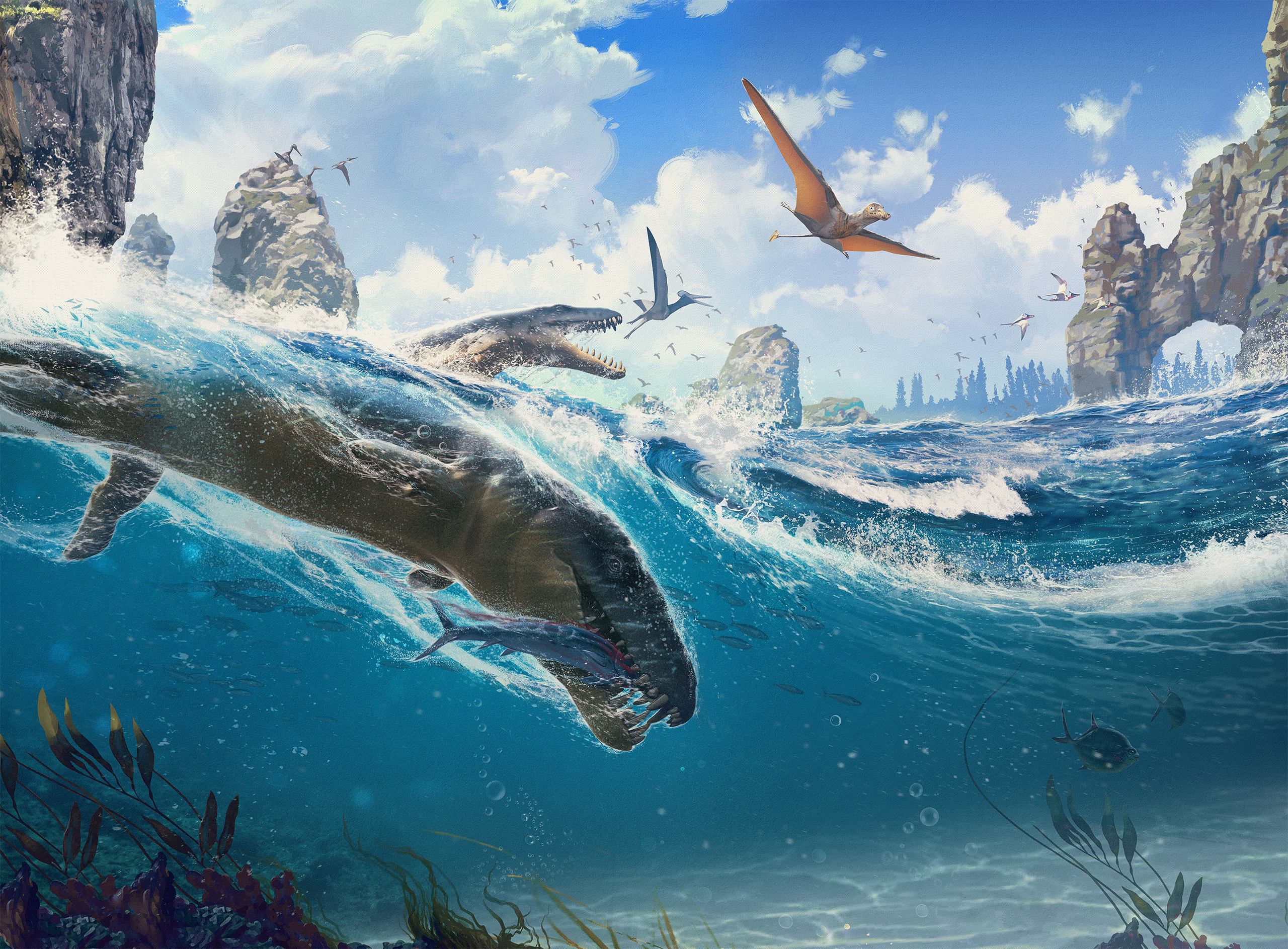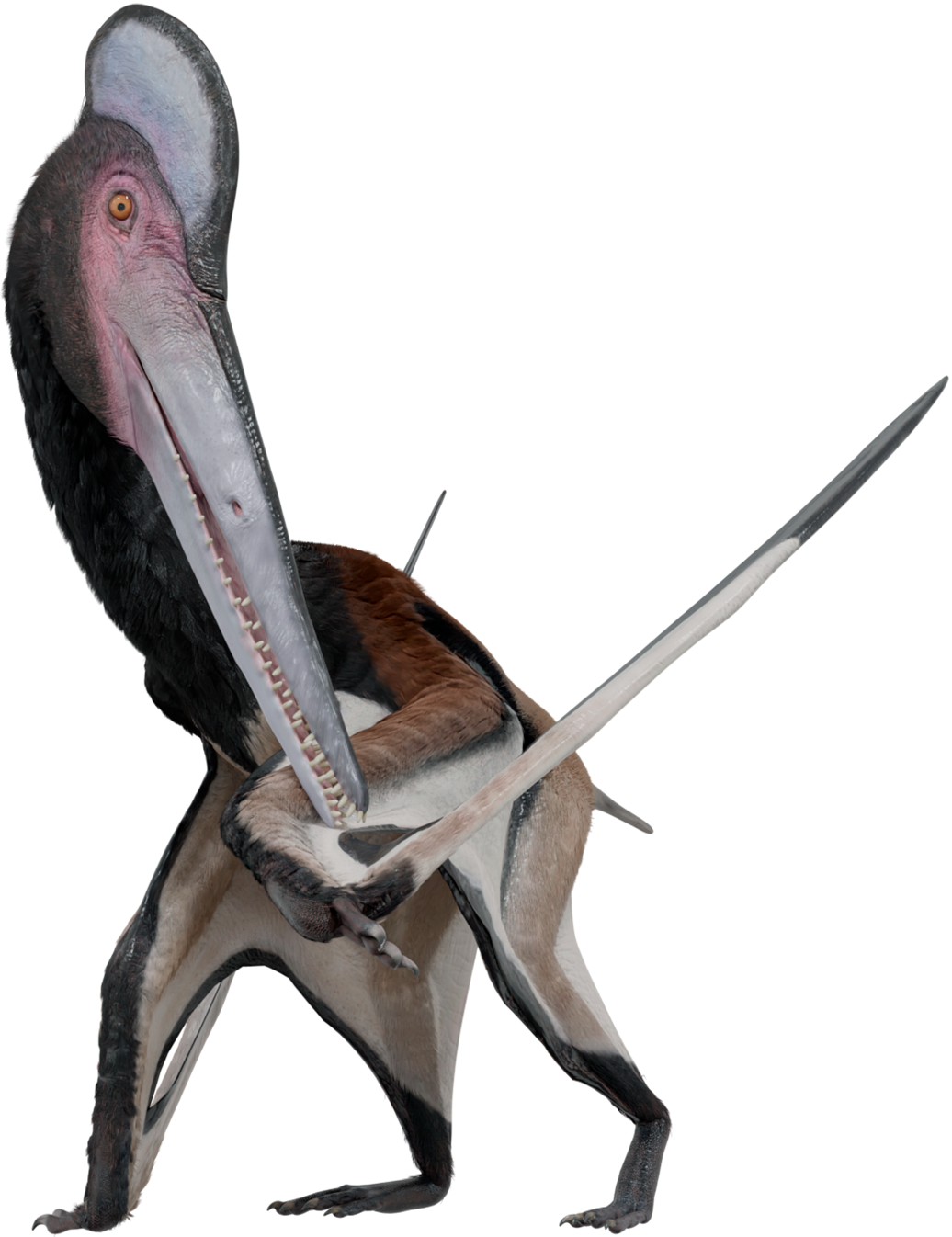The Original "Winged Finger"
Nicknamed "pterodactyl", this Jurassic pterosaur was the first of its kind to be described. Despite often being confused with the much larger pterosaur Pteranodon, Pterodactylus itself was very small, only about as big as a sparrow!
Overview: Pterodactylus, also nicknamed "pterodactyl", discovered in the late 18th Century and named in the early 19th Century, was the first flying reptile ever described by science, the archetypal pterosaur. Known from multiple complete specimens wonderfully preserved in the famous Solnhofen Limestone of Bavaria, Pterodactylus was the prefect fossil to introduce the world to the pterosaurs, which were an alien concept to early paleontologists when Pterodactylus was first described. The nickname “pterodactyl” is often incorrectly applied to pterosaurs in general, and often associated with the large, prominently crested genus Pteranodon, but the real Pterodactylus was a small animal, which only had a small crest and ate mostly insects.
Discovery: Pterodactylus was discovered in the famous Solnhofen Limestone in Bavaria, Germany. It was first reported in 1784 by Cosimo Alessandro Collini, curator of the Naturalienkabinett (nature cabinet of curiosities, an early version of a Natural History Museum) in the palace of Charles Theodore of Bavaria at Mannheim. It was originally found in a limestone quarry in Eichstätt, but the year it was found is unknown, but probably after 1767 and before 1780, making it one of, if not the earliest documented pterosaur discovery. It was certainly the first to be identified as a pterosaur, though this took a few decades. Collini had no idea what the specimen was, and assumed it was a marine creature of some sort. Johann Hermann was the first to suggest the elongated fingers would have supported a wing membrane, though he thought it was a mammal, and in 1800 he alerted Georges Cuvier of its existence and recommended that he publish on it. In 1801, Cuvier did publish a brief description of the fossil. He agreed that the finger supported a wing membrane but disagreed with Hermann’s interpretation of it as a mammal, instead thinking it a reptile, which was correct. In 1809, Cuvier published a longer description in which he named the fossil Ptéro-Dactyle, meaning “winged finger”, from Greek “pteros” (winged) and “dáktylos” (finger). Funny enough, he originally misspelled it as “Petro-Dactyle” but corrected it in a later publication. A few years later the name was latinized as Pterodactylus, and the species name antiquus, meaning “ancient” was added. Since then, over 30 specimens (most of them juveniles) have been found in the Solnhofen Limestone, and thanks to the extraordinary preservation of Solnhofen fossils, many are complete skeletons, making this a very well-known species.
Evolution: Pterodactylus was a pterosaur, a flying reptile with membrane wings supported by a hyper-elongated fourth finger. Pterodactylus was a basal (“primitive”) pterodactyloid, or short-tailed pterosaur, more derived (“advanced”) than the long-tailed pterosaurs which appeared earlier. Other long-tailed pterosaurs include ornithocheirans like Anhanguera, azhdarchids like Hatzegopteryx, and pteranodonts like Pteranodon, which is probably the most iconic pterosaur, and itself was once considered a species of Pterodactylus.
Description: Pterodactylus was a small pterosaur with a wingspan of 1.04 meters (3.42 ft). Like other pterosaurs it was extraordinarily lightly built with a delicate skeleton of hollow bones. It had a long straight beak with about 90 small, narrow, conical teeth which got smaller further back in the jaws. Like its distant relative Pteranodon, Pterodactylus did have a crest, however, it was smaller, and it was mostly made of soft tissue. Mature adult Pterodactylus had a small boney crest which would have supported a larger soft tissue crest. These crests would have been brightly colored and grew larger with maturity. Like dinosaurs and other pterosaurs, Pterodactylus was probably warm blooded and covered in a coat of fur-like primitive feathers called pycnofibers. However, they had a slower, more reptilian growth rate and may have run cooler than other warm-blooded animals.

Behavior and Ecology: Pterodactylus lived in the Tithonian age of the Late Jurassic Period. Back then, the Tethys Sea had flooded much of Europe. Island land masses dotted the shallow seas of Europe and provided homes for pterosaurs and dinosaurs. The Solnhofen Limestone of Bavaria was a sheltered tropical lagoon between an island archipelago and a coral reef. Despite being surrounded by water, these islands were somewhat dry, getting little rain, and the plants that grew there were mostly shrubs. Larger trees were rare, with most maxing out around 3 m (10 ft). These would have included conifers and Cycads. The flora would have resembled that of modern New Caledonia, albeit with a drier climate. The sea surrounding the islands would have been warm and shallow, with clear water and abundant carbonate-forming plankton. These plankton used calcite (calcium carbonate) to form tiny shells, and when they died, these shells would collect on the sea floor, eventually becoming limestone. The Solnhofen Lagoon itself would have varied in depth, at times almost drying up and become hyper-saline (saltier than normal seawater). Due to its limited connection to the rest of the sea, the lagoon also had poor circulation which often resulted in anoxia (low to no oxygen). Because of this, there wasn’t always a lot living in the lagoon itself, particularly lower in the water column. Because of the lack of scavengers and the generally calm water, when animals died in the lagoon, they were often gently buried by the carbonate mud (dead calcite plankton) and left undisturbed, resulting in near perfect preservation.
Pterodactylus would have lived on the islands at the edge of the Solnhofen Lagoon, and it shared its environment with numerous other pterosaurs, including the long-tailed pterosaur Rhamphorynchus. On land, it shared the trees/shrubs with the early bird Archaeopteryx, and the small bird-like theropod Compsognathus would have occupied the ground. Both Archaeopteryx and Compsognathus were predators and may have preyed on Pterodactylus and other small pterosaurs, if they could catch them. Pterodactylus had a relatively high bite force, which it probably used to munch on insects. Studies on its sclerotic rings (rings of bone that are set in the eyes of some animals) suggest that Pterodactylus was diurnal (active during the day), whereas some of the other pterosaurs of Solnhofen were nocturnal, and this division of night and day shifts for different species probably helped the numerous pterosaurs to avoid competition with each other.
The crests of Pterodactylus were used for display, specifically as a breeding display. This is supported by the fact that adults had proportionally larger crests than juveniles. The crests of the males may have been larger and more colorful than the females, and they may have competed with each other for the females’ attention.
Extinction and Legacy: Pterodactylus seems to have disappeared around 148.5 million years ago. The reasons are unknown. All species in the fossil record eventually go extinct or evolve into something new, and such may have been the case with Pterodactylus. Today, Pterodactylus can be found at many museums, including the Natural History of Verona, in Verona, Italy, the American Museum of Natural History in New York City, New York, USA, and the Bavarian State Collection for Palaeontology and Geology (which holds the holotype). Despite being such a famous animal, Pterodactylus has found its way into relatively little media. However, the name “pterodactyl” has become almost synonymous with pterosaurs generally, and thus has been referenced often, whether or not it is actually referring to Pterodactylus itself. A Pterodactylus does appear in the 1974 film The Land That Time Forgot. It also appears in the 2023 Netflix documentary Life of Our Planet, though it is not named on screen.
Pterodactylus FAQ
Pterodactylus size / How big was Pterodactylus?
See wingspan and weight.
Pterodactylus wingspan
Pterodactylus had a wingspan of up to about 1.04 meters (3.42 ft).
Pterodactylus weight / How much did Pterodactylus weigh?
Pterodactylus probably only weighed up to about 0.35 kg (0.77 lb).
How long was Pterodactylus?
Pterodactylus grew to be about 0.62 meters (2 ft) in length.
How tall was Pterodactylus?
On the ground, an adult Pterodactylus stood about 0.56 m tall (1.8 ft).
What did Pterodactylus eat?
Pterodactylus was a small carnivore, probably preying upon mostly insects, as well as small vertebrates.
What is Pterodactylus’s closest living relative?
Like all pterosaurs, the closest living relatives of Pterodactylus are the birds, since birds are dinosaurs, and pterosaurs are closely related to the dinosaurs in the clade Avemetatarsalia. Crocodilians, while not avemetatarsalians, are members of the larger clade Archosauria, which also includes avemetatarsalians, thus crocodilians are also cousins of the pterosaurs, albeit more distant than birds.
Pterodactylus family members / Pterodactylus family / What kind of animal was Pterodactylus?
Pterodactylus was a type of pterosaur (flying reptile) in the clade Pterodactyloidea (short-tailed pterosaurs).
Where did Pterodactylus live? / Where was Pterodactylus found?
Pterodactylus lived in an island environment in what is now Germany.
When did Pterodactylus live?
Pterodactylus lived about 150.8 to 148.5 million years ago in the Late Jurassic Period.
What does Pterodactylus mean? / Pterodactylus name meaning
Pterodactylus means “wing finger”.
Is Pterodactylus the same thing as a “pterodactyl”?
Well yes, but sometimes no. The nickname “pterodactyl” comes from “Ptéro-Dactyle” the fossil’s original name before it was latinized to Pterodactylus. So “pterodactyl” is sort of a common name for Pterodactylus. However, sometimes it is incorrectly used to reference any member of Pterodactyloidea, particularly Pteranodon. Nevertheless, in the strict and proper sense, pterodactyl is a common name referring only to Pterodactylus.

